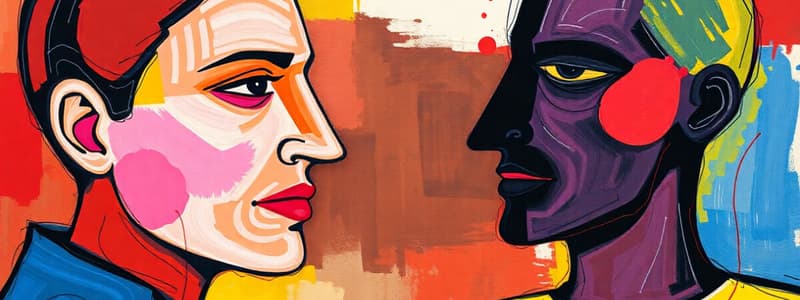Podcast
Questions and Answers
What is an example of Anchoring Bias?
What is an example of Anchoring Bias?
- Making a decision based solely on first impressions. (correct)
- Relying on social media for initial news coverage.
- Choosing data that supports existing beliefs.
- Adhering to group opinions despite personal beliefs.
Which type of bias is characterized by selective story reporting by journalists?
Which type of bias is characterized by selective story reporting by journalists?
- Conformity Bias
- Confirmation Bias
- Halo Effect
- Media Bias (correct)
Which of the following is NOT a category of prejudice?
Which of the following is NOT a category of prejudice?
- Racism
- Ageism
- Personal Bias (correct)
- Sexism
What does Confirmation Bias lead individuals to do?
What does Confirmation Bias lead individuals to do?
What describes the Halo Effect?
What describes the Halo Effect?
Which statement is true regarding the difference between bias and prejudice?
Which statement is true regarding the difference between bias and prejudice?
What type of prejudice involves assumptions based on social class?
What type of prejudice involves assumptions based on social class?
Which of the following is an example of prejudice?
Which of the following is an example of prejudice?
Flashcards
Bias
Bias
An unfair preference or opinion that influences judgment.
Anchoring Bias
Anchoring Bias
Relying heavily on initial information, hindering alternative perspectives.
Media Bias
Media Bias
When journalists choose stories and coverage influenced by their own biases.
Confirmation Bias
Confirmation Bias
Signup and view all the flashcards
Conformity Bias
Conformity Bias
Signup and view all the flashcards
Halo Effect
Halo Effect
Signup and view all the flashcards
Prejudice
Prejudice
Signup and view all the flashcards
Racism
Racism
Signup and view all the flashcards
Study Notes
Bias
- Bias is an unfair preference or opinion that influences judgment
- Bias is often used interchangeably with prejudice despite having negative consequences
- Anchoring Bias occurs when people rely heavily on the initial information they encounter, making it difficult to consider alternative perspectives
- Media Bias occurs when journalists or news producers choose which stories to report and how to cover them, often influenced by their own biases
- Confirmation Bias is the tendency to prioritize information that confirms pre-existing beliefs and ignore contradicting information
- Conformity Bias involves making decisions that align with the majority opinion, even if it conflicts with personal beliefs, to fit in
- Halo Effect occurs when positive perceptions of one trait influence positive perceptions of other related traits, often seen in attractiveness stereotypes
Prejudice
- Prejudice is a pre-conceived opinion or feeling formed without sufficient knowledge or reason
- Prejudice can be categorized into:
- Racism: Prejudice based on race, often involving assumptions about groups of people
- Sexism: Prejudice based on sex or gender, often leading to biased treatment and assumptions
- Classism: Prejudice based on social class, resulting in discrimination and stereotypes
- Ageism: Prejudice against older people, often based on assumptions about their abilities and contributions
- Religion: Prejudice based on religious beliefs, leading to negative attitudes and discrimination
Bias vs. Prejudice
- Bias can be positive or negative, while prejudice is typically negative.
- Bias results in unfairness, while prejudice results in discrimination.
- Examples of bias include favoring certain students in grading or selecting news stories that benefit the media organization
- Examples of prejudice include assuming someone is mentally disabled because of a physical disability or making assumptions about all Muslim women being illiterate
Studying That Suits You
Use AI to generate personalized quizzes and flashcards to suit your learning preferences.



